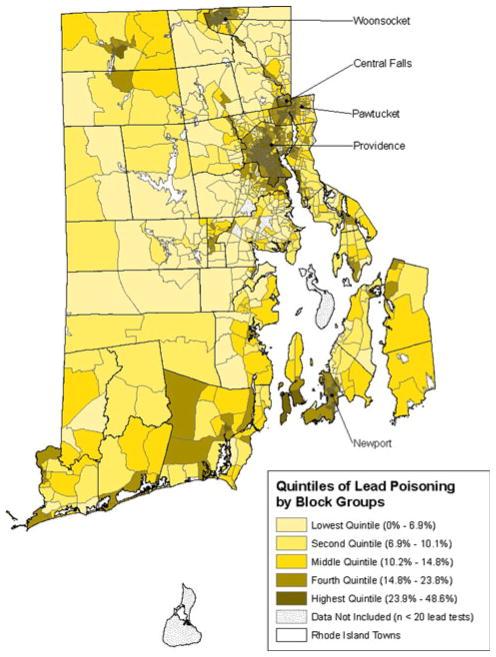
Toxins and other health threats can cause health problems, whether they are present in the child’s own home, other neighborhood homes where the child spends time, or common areas such as playgrounds. This study assesses the impact of where a child lives on the burden of lead poisoning. Statewide lead screening data was obtained from the Rhode Island Department of Health. Block group level indicators of old housing and poverty were obtained from the US Census. Of the 204,746 study children, 35,416 (17.3%) had a blood lead level ≥10 μg/ dL. The proportion of study children who were lead poisoned in each block group ranged from 0.0 to 48.6%. The proportion of study children with an elevated blood lead level increased from 8% among children living in block groups in the lowest quintile of poverty to 31% for those in the highest quintile for poverty. Old housing also had an important impact on the risk of lead poisoning. The proportion of children with an elevated blood lead level increased from 7% among children living in block groups in the lowest quintile for pre-1950 housing to 27% for those in the highest quintile for pre-1950 housing. The adjusted odds ratio was 1.64 for the highest quintile of poverty and 1.77 for the highest quintile of pre-1950 housing. The findings of this large, statewide study demonstrate the powerful impact of where children live on the risk of lead poisoning. The findings have important implications for understanding the problem of lead poisoning and for planning primary prevention programs.
Vivier, P.M., Hauptman, M., Weitzen, S.H., Bell, S., Quilliam, D.N. and Logan, J.R., 2011. The important health impact of where a child lives: neighborhood characteristics and the burden of lead poisoning. Maternal and child health journal, 15(8), pp.1195-1202.
